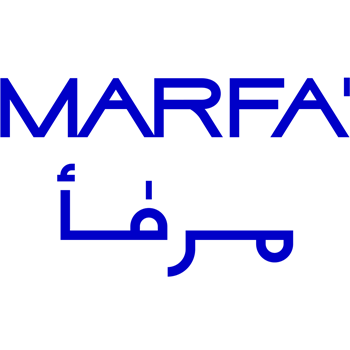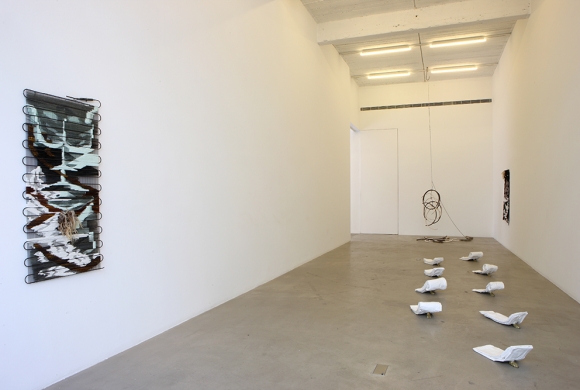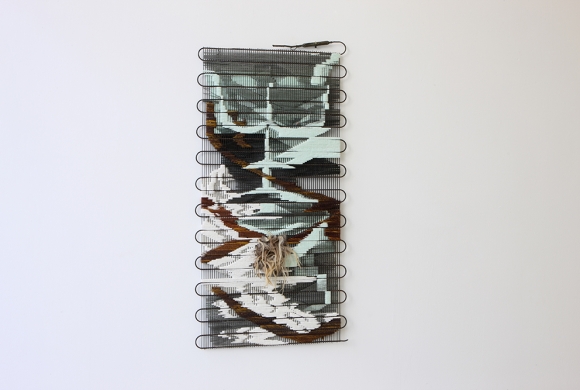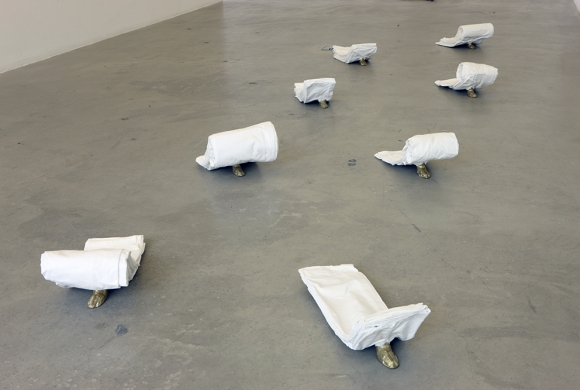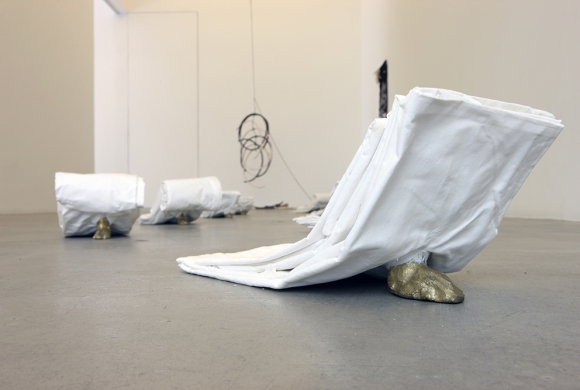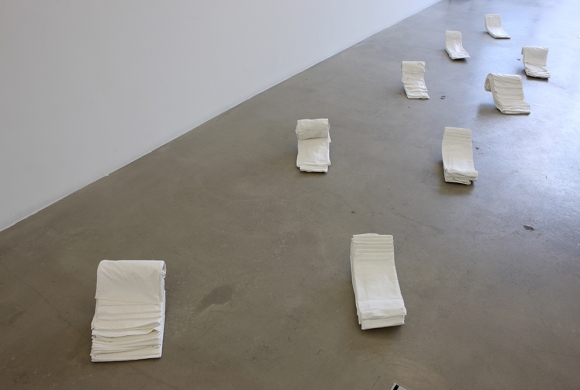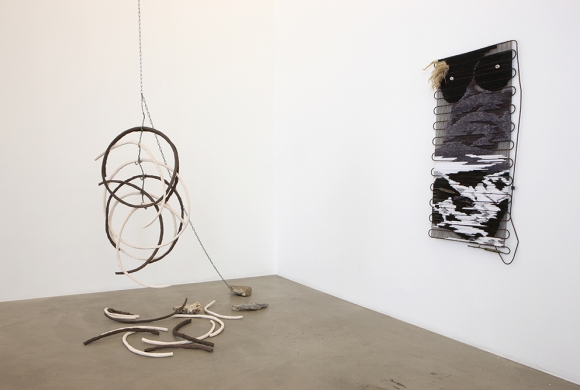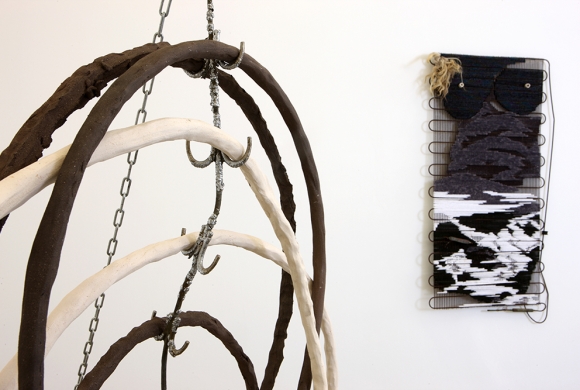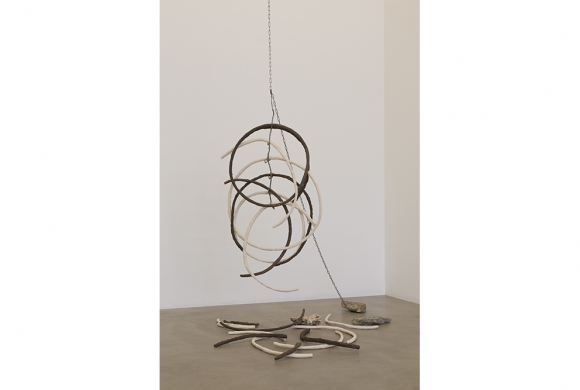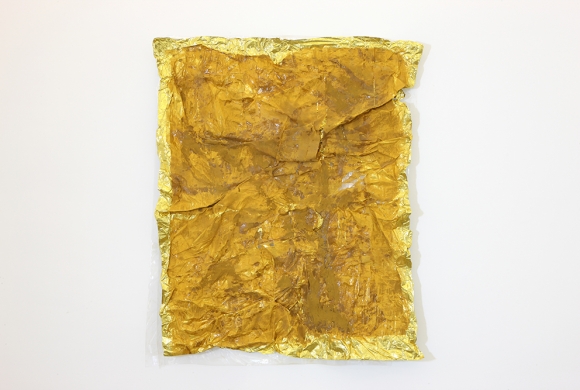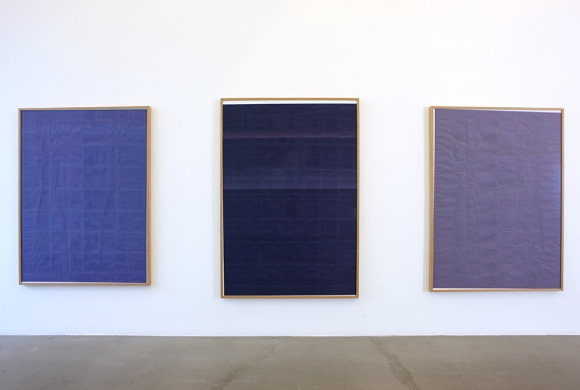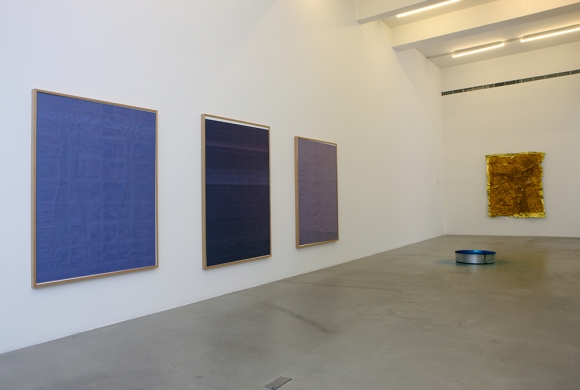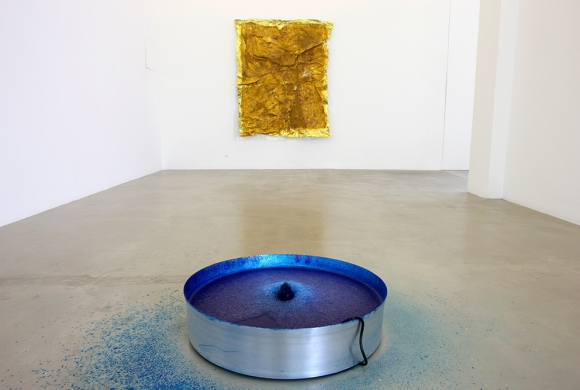Group Show
That is Water, That is Earth
20 September 2018 - 22 December 2018
That Is Water, That Is Earth
Marfa’ presents That Is Water, That Is Earth, a group exhibition of works by Caline Aoun, Hera Büyüktaşçıyan, Dala Nasser, Zoë Paul, curated with Mari Spirito. Artworks in That Is Water, That Is Earth are linked by navigation of the conditions of our times, giving materiality to the immaterial aspects in our societies.
Accompanying factors such as rapidly shifting societal and economic structures, as well as psychological and emotional aspects of this transition into the Digital Age, give way to these four responsive voices. Fluidity, in this case, a metaphor for ideas, information and historical time, is constant yet never the same, uncertain and layered. Hera Büyüktaşçıyan’s installation, The Wanderer’s Storm-Song, 2018, takes its title from Johann Wolfgang von Goethe’s poem of the same name and spreads several stacks of domestic white pillowcases across the gallery floor. Each stack lifts up off the floor, revealing small brass feet. In this form, the pillowcases become waves, which are inspired by vibrations of memory and reflect movement of people throughout various times in history. Each object, made of a material formerly used to rest your head, to dream, has been transformed into the curl or break of a wave. The white foam of crashing wave signals the moment when the energy of the wave comes in contact with land and becomes another kind of energy. Looking at Büyüktaşçıyan’s work through the lens of geological time, we ask: What has happened here before us? What will happen after us? Sensitivity to urban transformation and disappearance of populations bring to the surface invisible cycles as well as our shifting attitudes towards them.
Caline Aoun’s work is a focused series of experimental correctives, inversions, and resting places in a historical moment of peaking visual noise. This is done not out of an ideology of urban environmentalism, but by posing the question of what happens when this noise becomes total? Image saturation and the exhaustion that follows, the uncountable ways in which representation has failed us, these forces converge to form new baselines of experience, newly informed silences, dark and blank spaces for us to reflect upon. Dispersions, 2017-ongoing, is a series of unique inkjet prints on folded and crumbled paper. Like most of her unique inkjet prints, they are overridden by their material qualities and surfaces. Here, the ink droplets have landed onto the paper during the printing process in such a way as to create light and shadow effects as a consequence of the papers’ folds. In Aoun’s work, water is also a recurrent motif, where the washing of, or wearing away of the image is presented as a sort of cleansing, or return. In Fountain 2, 2018, water has been replaced by a printer’s Cyan ink. Water isn’t blue but appears blue and is widely represented as so. The ink in the fountain has no destination, it’s traffic and movement does not end onto a paper as to represent some data or information from a computer, but rather is renewed and circulated in an endless loop inside the fountain.
Zoë Paul’s new installation, Hoops at the shoreline of the sea,2018,is part of her ongoing research into sculpture as remnant of the performance of making and/or social engagement. The traditional game of hoops is made by drawing circles in the sand. Players throw stones into each circle, the goal is to get the most stones inside each circle. Play is a form of emotional bonding, it brings people together to collaborate and to be innovative. Play and games also embody elements of competition, aggression, a climate of “us vs them” and supremacy over another. Paul’s new work consists of ceramic hoops, suspended from the ceiling by a thin chain that is then weighted to the floor by a stone. Inside each clay hoop structure there is a metal armature. The metal supports its architecture yet also reacts to the heat in the firing process the hoops, rendering them each fragile and elegant remnants of game play. Additionally, two untitled works from 2017, by Zoë Paul, are weavings representing a woman and a man. Paul’s weavings are made on discarded refrigerator grills. Prior to the arrival of the fridge, people from different families ate livestock together, sharing food that could not be kept fresh/safe for a long period of time. After the arrival of the fridge, families ate in each of their homes, separated from each other, which was seen as the advancement of modernization, and is now considered as a factor in the break down of communities, in the isolation of people from each other, eating food, each from their own isolated storage. Paul is skeptical of the so-called advancements of the current conditions of our times. Her reflections question constructive progress and modern living. The making of Paul’s work frequently involves groups of people, working with natural materials by hand, who at times are temporary communities. Paul’s communal process is as much part of her works as her objects.
Dala Nasser’s new works, I’m not going to talk about that, and Practice over Product I &II, all 2018,are comprised of liquid latex, resin, discarded plastic sheets, mylar blankets, and mineral pigments, revealing a variety of chemical processes with translucent burnt areas and heavily pigmented in other areas. Each work hangs on rigs, out from the wall, about 50 cm, where it is able to move with the air and movement in the space, as well as exercise its own temporality. Nasser’s works portray the refusal of the cultural confinement of the racialized and gendered artist, that is supported in mainstream and social media and then embodied in different ways by different communities. Grounding her practice through the questions of material and modern processes, she sets out to produce works that respond to their physical, and contextual components, evolving autonomously over time. Nasser’s sculptural forms embody her relationship to hegemonic narratives and discharge a continuous push-back against structural expectations with materiality at their center, expanding on a dialogue for change in societies at home and abroad.
Access to more information has the ability to open up new ways of thinking, new understandings of everything, including time, history and each other – new ways that have yet to be conceived. Caline Aoun, Hera Büyüktaşçıyan, Dala Nasser, Zoë Paulare some of the artists of this moment working with related concerns from different perspectives, in different modes and materials, connected by a fluidity. That Is Water, That Is Earth investigates possible ways to express many notions of these times, and attempts to grasp the expansion of being, that is both of this earth/material and not/immaterial.
Caline Aoun (b.1983, Beirut) lives and works between Beirut and London. She graduated with a Bachelor’s degree in Fine Art from Central Saint Martins, London, in 2005. In 2009, she received a Postgraduate degree in Fine Art from the Royal Academy School, London. She also earned a Professional Doctorate in Fine Art at the University of East London, London in 2012. Her work has been recently exhibited at the MAXXI, Rome, Centre For Contemporary Art Ujazdowski Castle, Warsaw, Poland, Mosaic Rooms, London, UK, Casa Árabe, Madrid, Spain, Casa Árabe, Cordoba, Spain, Art Basel, Basel, Switzerland. Aoun is Deutsche Bank’s Artist of the Year 2018. In autumn 2018, she will present her first large-scale institutional solo exhibition at the MAXXI, Rome.
Hera Büyüktaşçıyan (b. 1984, Istanbul) graduated from Marmara University, Faculty of Fine Arts, Painting department in 2006. Past residencies include Delfina Foundation, London; Villa Waldberta, Munich; AIRDrop, Stockholm; PiST/// Interdisciplinary Project Space, Istanbul; and ACSL, Yerevan. Selected exhibitions include: solo exhibition at Institut für Auslandsbeziehungen (ifa) Gallery, Berlin(forthcoming); Underneath The Arches, Naples, 2018; Write Injuries on Sand and Kindness in Marble, Green Art Gallery, Dubai, 2017; Armenity, Armenian Pavillion, 56th Venice Biennale, Venice, 2017; Saltwater, Istanbul Biennial, Istanbul, 2015.
Dala Nasser (b.1990, Beirut) lives and works in Beirut after having completed her BFA in London at UCL’s Slade School of Fine Arts in 2016. She was awarded the Boise Travel Scholarship and the Sursock Museum’s 32nd Salon D’Automne Emerging Artist Prize. Selected exhibitions include Surface Work at Victoria Miro, London, 2018; The Pain of Others, Ghebaly Gallery, Los Angeles, 2018; An Unpredictable Expression of Human Potential, ACT II of the Sharjah Biennial 13, Beirut Art Center, 2017; Ghosting of Beings and Worlds, Greynoise Gallery, Dubai, 2017; 32nd Salon D’Automne,Sursock Museum, Beirut, 2016.
Zoë Paul (b.1987, London) lives and works in Athens. After finishing her undergraduate at Camberwell College of art, she completed her MA in Sculpture at the Royal College of Art, London. Selected exhibitions include: La Perma-Perla Kraal Emporium, SPIKE Island, Bristol, 2018; La Perma-Perla Kraal Emporium, The Breeder, Athens, 2017; Equilibrists organized by the New Museum, New York and the DESTE Foundation, Athens at the Benaki Museum, Athens, 2016; Solitude and Village, The Breeder, Athens, 2016; Unorthodox at the Jewish Museum, New York, 2015.
